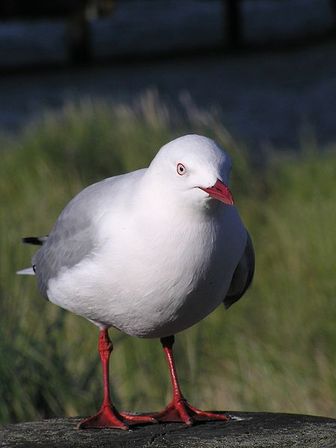Red-billed Gull
The Red-billed Gull , once also known as the Mackerel Gull, is a native of New Zealand, being found throughout the country and on outlying islands including the Chatham Islands and Sub-antarctic islands.The Māori name of this species is Tarapunga or Akiaki. Its vernacular name is sometimes also used for the Dolphin Gull, a somewhat similar-looking but unrelated species. As is the case with many gulls, the Red-billed Gull has traditionally been placed in the genus Larus.

Original source: Tony WillsPermission(Reusing this file)I, Tony Wills, the copyright holder of this work, hereby publishes it under the following licenses:Permission is granted to copy, distribute and/or modify this document under the terms of the GNU Free Documentation License, Version 1.2 or any later version published by the Free Software Foundation; with no Invariant Sections, no Front-Cover Texts, and no Back-Cover Texts. A copy of the license is included in the section entitled GNU Free Documentation License.www.gnu.org/copyleft/fdl.htmlGFDLGNU Free Documentation Licensetruetrue
Author: Tony WillsPermission(Reusing this file)I, Tony Wills, the copyright holder of this work, hereby publishes it under the following licenses:Permission is granted to copy, distribute and/or modify this document under the terms of the GNU Free Documentation License, Version 1.2 or any later version published by the Free Software Foundation; with no Invariant Sections, no Front-Cover Texts, and no Back-Cover Texts. A copy of the license is included in the section entitled GNU Free Documentation License.www.gnu.org/copyleft/fdl.htmlGFDLGNU Free Documentation Licensetruetrue
Permission: GNU Free Documentation License
The Red-billed Gull is classified as Least Concern. Does not qualify for a more at risk category. Widespread and abundant taxa are included in this category.
with many gulls, the Red-billed Gull has traditionally been placed in the genus Larus. More
Red-billed GullThe Red-billed Gull Larus scopulinus is a native of New Zealand, being found throughout the country and on outlying islands including the Chatham Islands and Sub-antarctic islands. It is the smallest gull commonly seen in New Zealand; a recent estimate of the population puts it at half a million birds in the country. Until recently it was regarded as a subspecies of the Silver Gull L. novaehollandiae found in Australia, and the two species are very similar in appearance. More
Red-billed gulls will eat anything from mollusks, fish, insects and worms to carrion and garbage. Canon 20D, Canon 70-200mm 2. More
The Red-billed Gull is small compared to other gull species and has a red bill, legs and feet. There is virtually no visible difference between the sexes. More
The red-billed gull or tarāpunga (Larus novaehollandiae) has a white body with grey wings tipped with black then white. Their bills and legs are red. They are 37 centimetres long – considerably smaller than black-backed gulls. Males weigh 300 grams and females about 260 grams. Red-billed gulls are found around the southern hemisphere in temperate and tropical regions. There are several subspecies, of which Larus novaehollandiae scopulinus occurs only in New Zealand. More
Red-billed Gulls breed between October and December in large densely packed colonies on sand spits, boulder banks, shellbanks, gravel beaches, rocky headlands and rocky islets. The nest, built mostly by the male with only a small input from the female is composed of dry grass, seaweed, twigs and feathers. It is a small mound with a depression in the centre. The two or more brownish coloured heavily blotched eggs are incubated by both parents for 24 More
Behaviorally, the Red-Billed gull is a typical gull. It is an aggressive scavenger and kleptoparasite. Large numbers now live in towns and cities (most New Zealand cities are coastal or nearly so), feeding out of rubbish bins. Nesting is in large colonies; the birds form pair bonds which endure across seasons, but there is a certain amount of extra-pair copulation. Courtship feeding is an important part of the preparation for mating. More
Family : Laridae
Genus : Larus
Species : scopulinus
Authority : Forster, 1844

